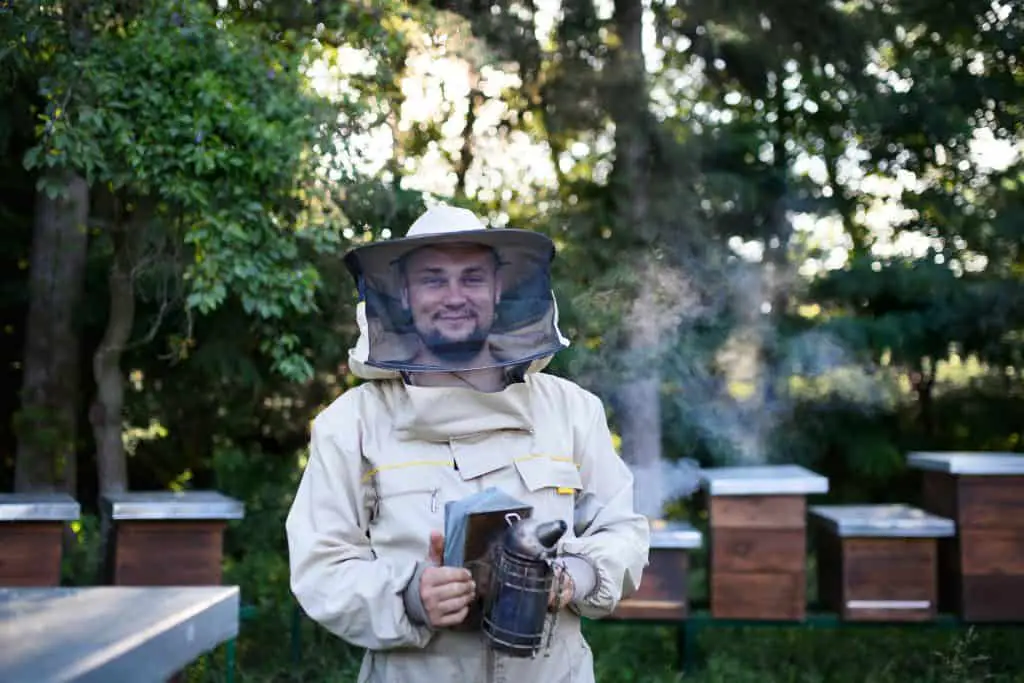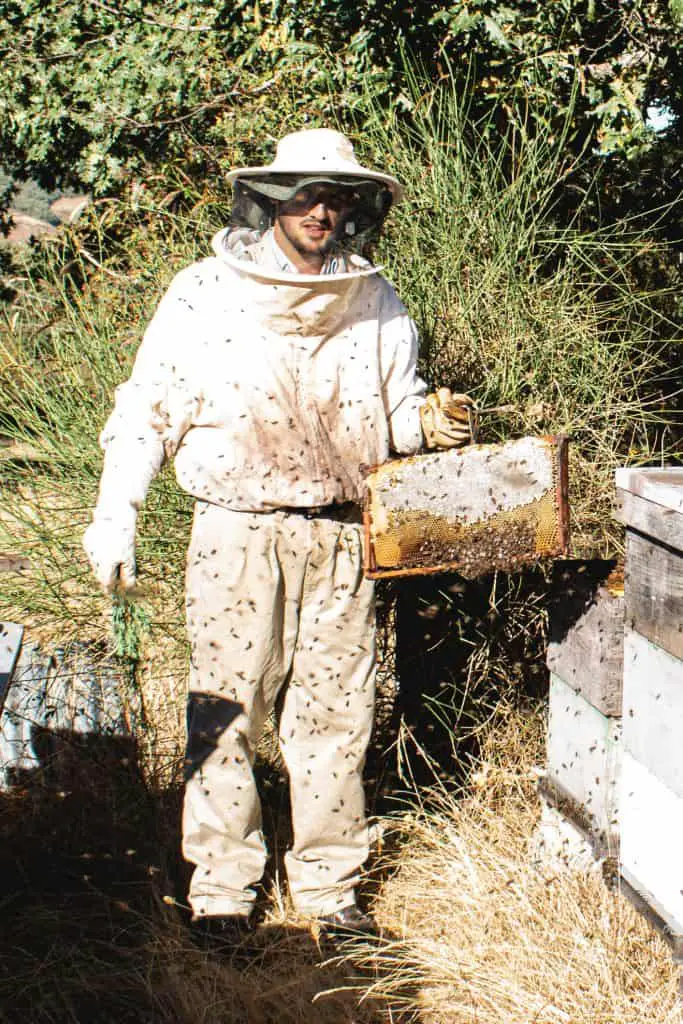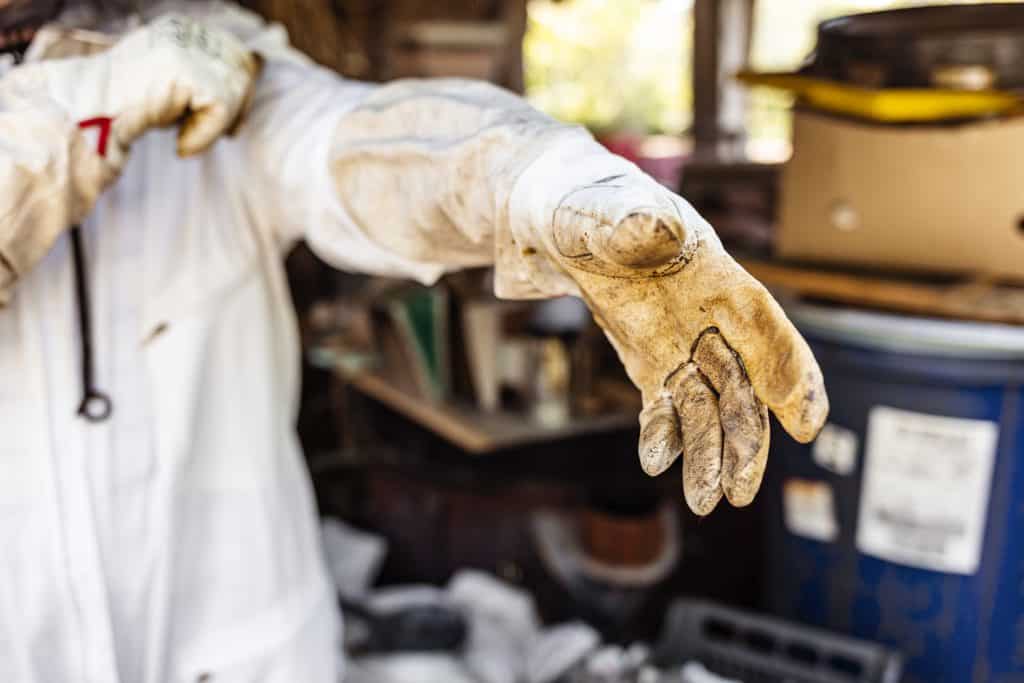If you own a beekeeping suit or are looking to purchase one, you might be wondering how to wash such an important piece of equipment. Luckily, it is pretty easy to wash a beekeeping suit, and this article will walk you through how to do it.
What is a Beekeeping Suit?

Beekeeping suits are special clothing that is made to protect beekeepers from bee stings. While honey bees are fairly docile animals and rarely sting, they can sometimes be unsettled and provoked by regular activities associated with beekeeping. Things like hive inspections and honey extraction can rile up the bees and make them more likely to sting. Therefore, beekeepers need to wear special suits to keep them safe from bee stings.
Why Are Beekeeping Suits Often White?
Beekeeping suits are white for two reasons. The first is that many natural predators of honey bees are dark-colored, including bears and skunks. Because of this, honey bees have a natural dislike of dark colors, and dark-colored clothing may make them more aggressive towards a beekeeper. The second reason that beekeeping suits are white is that they absorb less heat from the sun, meaning that they can keep a beekeeper cooler in the summer than a dark-colored suit.
Clearly, the fact that beekeeping suits are white is reasonable. However, it does make keeping them clean quite difficult, as white fabric stains much more easily than other fabric. So how do you clean a white beekeeping suit? Keep reading to find out!
How Do You Maintain a Beekeeping Suit?
Before we even get to washing a beekeeping suit, knowing how to store and care for your beekeeping suit is essential. It is important to inspect your beekeeping suit regularly for any tiny holes that may appear. Because bees are so small, it is easy for them to crawl through even the smallest hole in a beekeeping suit, making it essential to detect and repair holes as soon as they occur. Every time you put on your beekeeping suit, check it for holes and ensure that your zippers are working properly to keep the suit sealed shut.
To store your suit, it is best to keep it hanging up in the closet. It shouldn’t be stored underneath heavy objects or in places where there are moths or other insects that eat fabric. It also should not be stored near sharp objects, as these can cause tears in the suit.
Why Should You Wash a Beekeeping Suit?

It’s important to wash your beekeeping suit for the same reason that you wash your other clothes: it gets kind of gross after a few days’ use! Additionally, the fabric may be damaged more easily if there is dirt built up in it, and can even become mildewy if exposed to moisture and not dried properly.
Even more importantly, bee pheromones can build up in the fabric of your beekeeping suit, which can become disturbing to your bees. Imagine smelling someone else’s old body odor – that’s how it feels for the bees! This is another reason that it is important to wash your beekeeping suit.
How Do You Wash a Beekeeping Suit?
Now we’ve finally gotten to the part where we actually discuss washing your beekeeping suit. The most important step in washing your beekeeping suit occurs when you buy your suit in the first place. It is essential to buy a suit that comes with a detachable veil so that the veil can be washed separately from the rest of the suit. This is because the veil is made from very delicate material and will easily rip in the washing machine, while the rest of the suit can typically be machine washed.
Before washing your suit, always check the label for washing instructions. While most beekeeping suits are machine washable with the exception of the veil, some will be labeled hand wash only, in which case they cannot be put in the washing machine. Follow whatever instructions are on the tags in your beekeeping suit for the best results.
To wash most beekeeping suits, the first thing you’ll do is detach the veil from the suit. If the veil is not detachable, you’ll have to handwash the whole suit. However, assuming that you’ve successfully removed your veil from your suit, you can put the rest of the suit minus the veil into the washing machine. Follow the instructions on the label, but typically you’ll wash it on cold or lukewarm on a gentle cycle and then hang it to air dry in the shade.
To wash the veil, you can soak it in water that contains unscented detergent for 15-20 minutes. Using your hands, move the veil through the water and scrub it gently to remove any sweat or buildup that is on it. Rinse it in clear water until it is no longer sudsy, and then hang it up to air dry in the shade. Use this same process for your beekeeping gloves.
It is essential not to use bleach or fabric softeners on your beekeeping suit. You can use unscented detergent in small amounts, but that’s about it as far as beekeeping suits go. If need be, you can use white vinegar to rinse your beekeeping suit the same way that you’d use liquid bleach.
It’s important not to wash your beekeeping suit with any of your other clothes, as it may have traces of pollen, propolis, and wax that could get on your other clothes and damage them. The only thing in the washing machine should be your beekeeping clothes.
How Do You Get Mildew Out of a Beekeeping Suit?
The best way to get mildew out of a beekeeping suit is by using white vinegar to kill the mold or mildew. While you can use bleach on normal clothes to get rid of mildew, it is important not to use bleach on beekeeping suits as the fabric is delicate and more expensive than ordinary clothing. You can soak your suit in a solution of vinegar and water to kill most mildew before washing it as described above. If there is just a spot of mildew, simply soak a sponge or cotton pad in the vinegar and place it over the stain for a few minutes.
How Do You Get Stains Out of a Beekeeping Suit?

Beekeeping suits often get covered in wax and propolis stains, as well as the more everyday dirt and grass stains. Removing these stains may seem difficult at first, especially because you can’t use bleach on a beekeeping suit, but there are ways to remove these stains.
For propolis stains, you can use products like Fels-Naptha or other strong, unscented soaps to reduce the appearance of the stain. It is nearly impossible to completely remove propolis stains, but they can be reduced pretty dramatically by this method.
For wax stains, scrape off any excess wax that you can get off of the suit. Then, pour very hot water down the back of the fabric on the side opposite the wax. So, assuming the wax is on the outside of your suit, you’ll pour hot water on the inside of the suit on the back of where the stain is. This will melt the wax off of the suit and allow it to drip off in its liquid form.
For dirt and grass stains, you can soak the garment in water that contains unscented soap. No matter how tempting it is, do not use bleach on your beekeeping suit. It’s better to have stains on your suit than a damaged or nonfunctional suit.
How Do You Get Honey Off of a Beekeeping Suit?
It is actually pretty easy to get honey out of a beekeeping suit, luckily enough. Simply scrape off all of the extra honey that you can remove, and then use unscented dishwashing liquid to rub the spot where the honey was. Keep using water and dishwashing liquid to scrub the spot until all of the stickiness is gone, and your suit is good as new.

